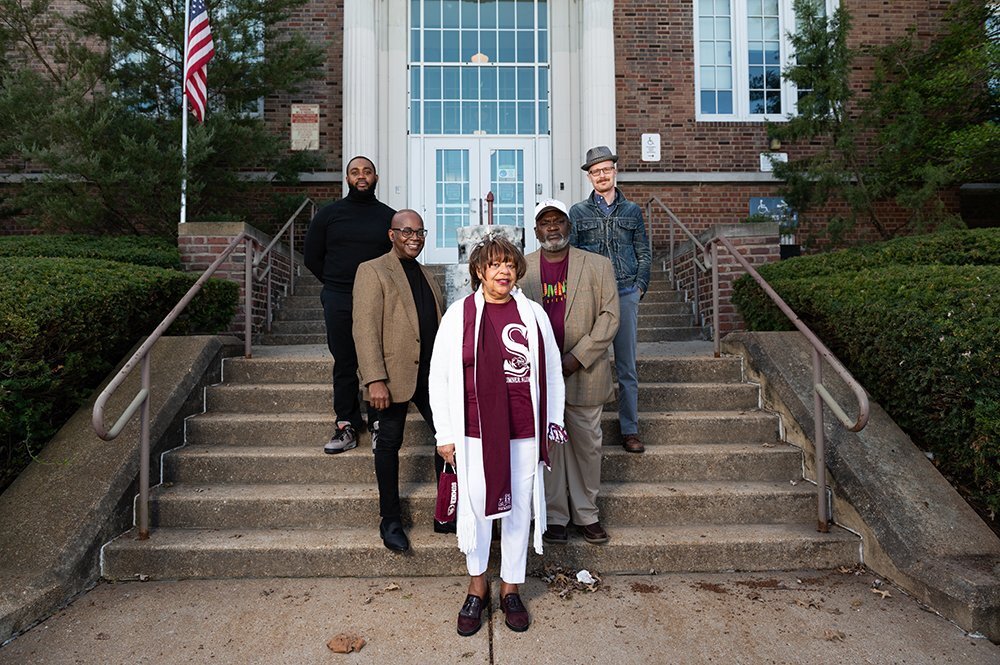The Ville History

“Experiences like this are not exclusive and are what make Sumner foundational to the identity and pride of The Ville. It is one of the institutions that has sustained my community despite the neglect it has received from the City.”
Julia Allen, 4theVille – Vice Chairperson

From left, 4theVille's Aaron Williams, alumnus Dr. Robert Salter, alumna Jacqueline Vanderford, alumnus Michael Blackshear, and St. Louis Shakespeare Festival's Tom Ridgely were some of the Ville leaders, artists, and alumni who penned a proposal to reimagine a new arts program for Sumner High School.
Community leaders, alumni, and arts organizations drew up an ambitious proposal. Their aim: Keep the historic school's doors open | By Amanada Woytus
The cash infusion has helped, but when Saint Louis Public Schools conducted a study to identify schools in need of closure last year, the district looked at enrollment, building conditions, capacity, impact on the neighborhood, and other special considerations. Census estimates reveal that the city continues to lose Black residents, which some blame on the disinvestment in North Side neighborhoods such as The Ville. “When Sumner was at its peak enrollment, the surrounding neighborhood of The Ville was also thriving,” SLPS Superintendent Dr. Kelvin Adams says. “It was a hub of African-American community and culture. As the neighborhood has declined over more recent years with the loss of Homer G. Phillips Hospital and other stabilizing landmarks—and the overall population of the city has declined—Sumner has mirrored that decline.”
The First Public High Schools in St. Louis
by Caoimhe Ni Dhonaill | Former MHS volunteer
The first public high school in St. Louis was founded in 1853, although it sadly closed in 1984, after 131 years. Known as Central High School, or simply “the High School,” this school was originally housed in a room of the public elementary school near Benton Park. In 1855 it relocated to a building at 15th and Olive that one commentator called the “most lavish schoolhouse west of New York.” It was a co-educational high school—one of the first in the United States—and by 1860 there were 301 students enrolled.
Throughout the 19th century, St. Louis Public Schools evolved into a model school district, earning several accolades. For example, in 1900 work created by local high school students won grand prizes at the Paris Exposition. Additionally, Central High School’s track team won the High School Athletics Championship of the World at the 1904 World’s Fair held in St. Louis.
However, it’s important to remember that these schools would have been completely closed to many St. Louis residents, because schools at this time were racially segregated. In 1845 a Catholic school for Black girls was opened, but it closed after a year due to public outcry at the education of African Americans. In 1846, Missouri passed a law that criminalized teaching African Americans to read and write. In response, it’s said that John Berry Meachum, a pastor of the First Baptist Church and a former slave, began to teach African Americans on a barge in the Mississippi River; the river was federally owned, which meant he could circumvent the state law.
In 1875, St. Louis’s first high school for African American students was founded due to a requirement in the Missouri Constitution of 1865 that school boards support Black education as well as white education. Sumner High School, originally located at 11th and Spruce, was named after the Massachusetts senator Charles Sumner, a famed champion of civil rights and emancipation. Sumner High School was the first African American high school west of the Mississippi and was viewed by many as one of the best such high schools in the country. Many parents from outside the city sent their children to live with relations in St. Louis just to attend Sumner. In 1954—more than 75 years after the founding of Sumner—St. Louis Public Schools officially desegregated.
Researching this article was a fascinating glimpse into the early history of St. Louis. By looking at this one facet of life in early St. Louis, I learned about the religious and ethnic foundations of the city, racial injustices and conflicts, and the development of state and local governmental attitudes toward education. Maybe the obsession with high schools in St. Louis is justified by this rich historical background.
Interested in learning more fun facts about St. Louis’s public high schools? Check out this post written by So, Where’d You Go to High School? author Dan Dillon. (Interestingly enough, Dillon’s book notes that St. Louis may not be so unique in its obsession with high schools—apparently “the question” is huge in Hawaii as well.)






